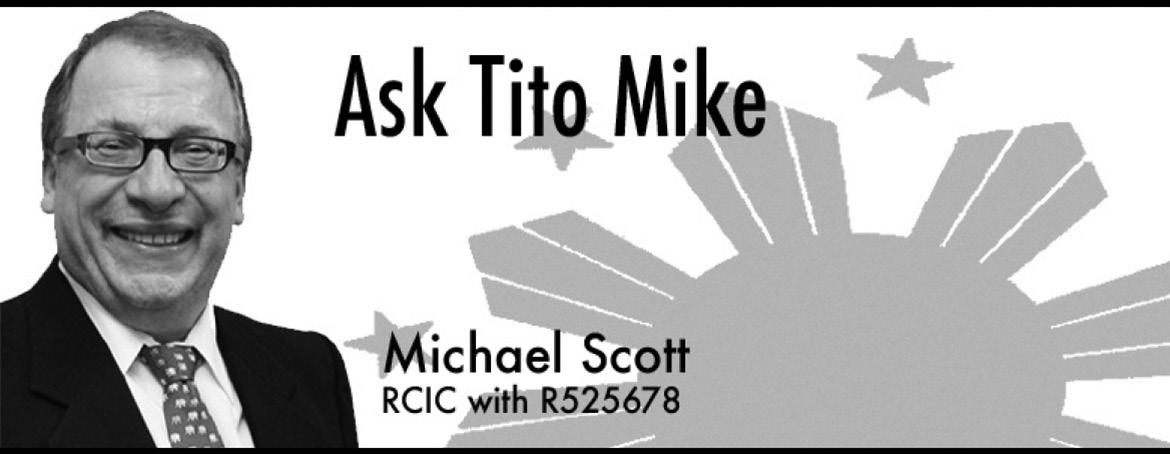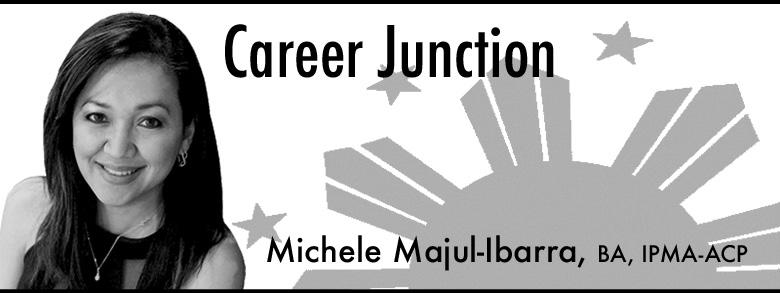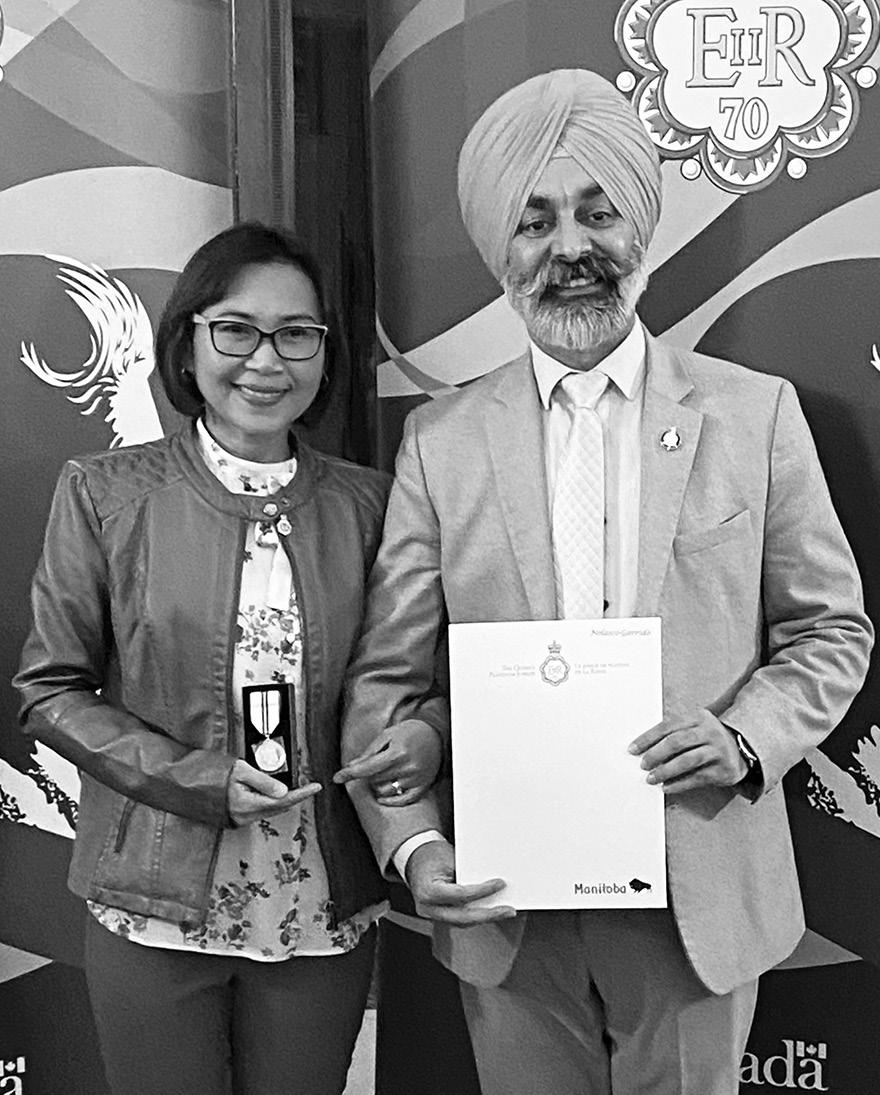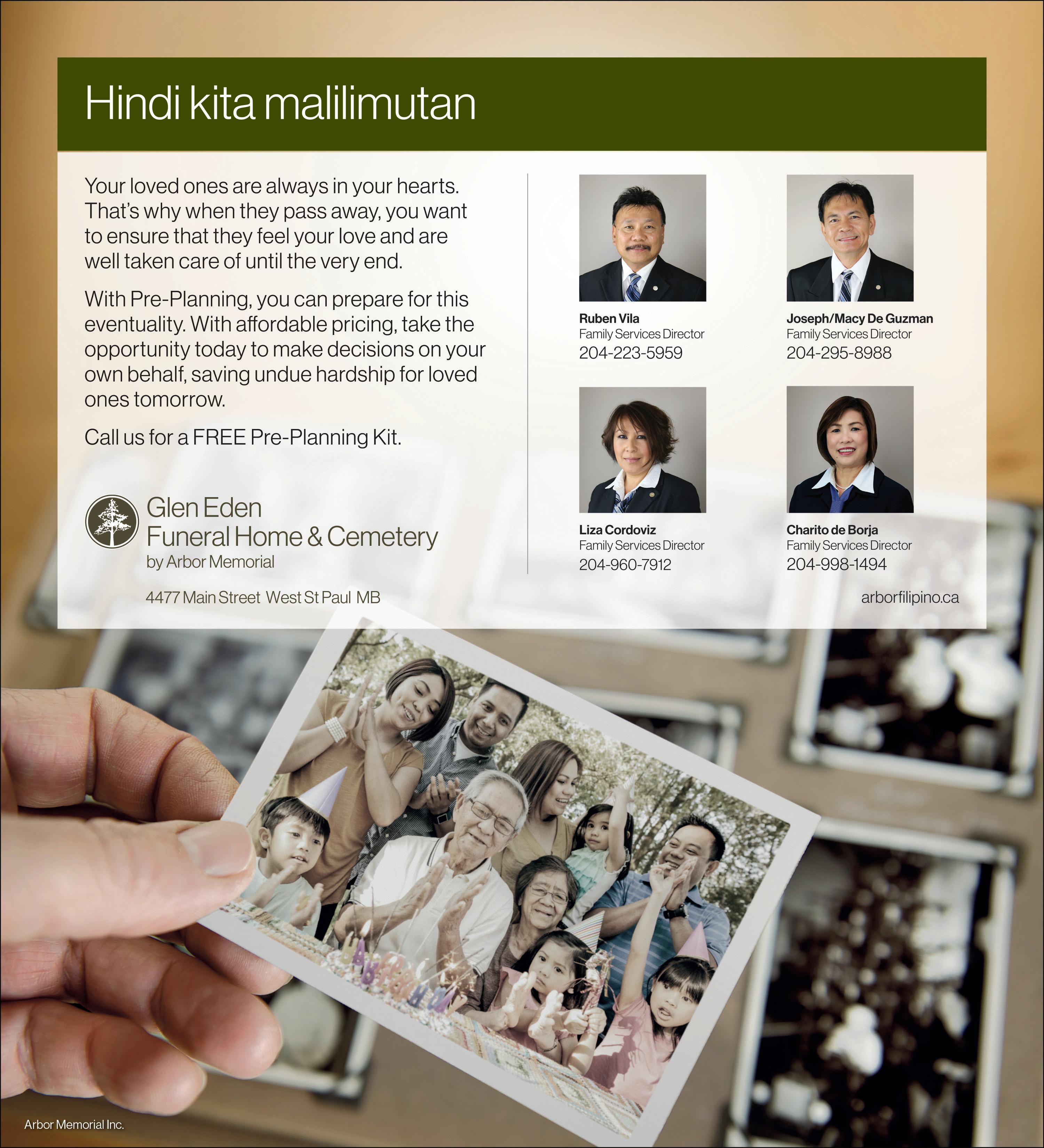8








This year, Queen Elizabeth II celebrated the 70th anniversary of her succession to the throne which began on February 6, 1952. Sadly, Queen Elizabeth II passed away on September 8, 2022, at the age of 96.
As a member of the Commonwealth of Nations, the

federal government of Canada has traditionally issued the Queen Elizabeth II Jubilee Medals to thousands of deserving Canadians from across the country, including the Silver, Golden and Diamond Jubilee Medals.
However, Ottawa decided not to proceed with the Jubilee
Medals this year.
So Provincial Protocol Officers from Manitoba, Saskatchewan, Alberta, Nova Scotia and New Brunswick agreed to proceed with the Provincial Queen Elizabeth II Platinum Jubilee Medals.
In Manitoba, the medal is a










On November 10, memories of my medical practice raced back to mind upon reading the Winnipeg Free Press article by Chris Kitching, “Children’s Hospital ER inundated.” It was at the Children’s that for many years I attended to neonates, infants, and children with respiratory diseases and held bedside teaching rounds with young doctors in training. I cannot recall a night or day in that time like the emergency room and ICU (intensive care unit) situations as described below that headline: “overflowing waiting room; children coughing everywhere; sick kids lethargic, gasping for air; respiratory therapists stretched thin; staff asked to work extra shifts or overtime; employees from other areas reassigned to the ICU; wait time as long as six hours even for an immune-deficient child; there wasn’t physical space to put people anymore.”
The news was so overwhelming that it felt like I was hearing the cries of infants and seeing the anxious looks of distraught parents. It made a part of me wish I were still in clinical practice.

The ER situation at the Winnipeg Children’s did not come unexpectedly. Three days earlier, Dr. Brian Garibaldi, director of the Johns Hopkins University Coronavirus Resource Center, had rung the alarm bells on the potential convergence of rising RSV (respiratory syncytial virus) and flu (influenza virus) infections amid the ever-present threat of a COVID-19 surge from a new variant. Deeply concerned, he wondered: “Can we sustain ourselves through these surges, provide care for the patients who need it, but also maintain the level of the workforce that we need to be able to care for all the other healthcare issues that are happening in people’s lives?”
While Garibaldi’s setting is in the USA, his deep concerns have since been validated in Canada.
CTV News reported on November 8, “‘We are so overwhelmed’: Children’s hospitals across Canada stretched as RSV cases, flu-like illnesses spike.”
Two patterns of disease behaviour with the three respiratory
viruses have contributed to their convergence during this cold season, for which the term “tripledemic” has been coined, namely, early arrivals and the arrival of greater numbers of the seasonal Flu and RSV infections amid the continuing circulation of COVID-19 Omicron subvariants.
One explanation given for the early and increased number of people getting sick this year from RSV and Flu is the lack of significant exposure over the last two years from these viruses and the resulting “immunity debt or gap” – so called when a child or adult lacks immunity or displays weakness of antibody response following infection because of “an unnaturally long period without prior exposure to any virus due to the masking and social isolation implemented to ward off COVID-19 during the last two pandemic years.
The viral villains
Diagnosis, treatment, and advice on the outcome of respiratory viral infection in infants and children are best done by the patient’s family doctor, pediatrician or healthcare provider.
The three respiratory viruses have their own distinct structure and properties. They cause different respiratory diseases and attack different parts of the respiratory tract. They also have a predilection for different age groups, show seasonal variation in occurrence, and cause variable severity between patients. They manifest subtle differences in signs and symptoms, which may vary in the onset of appearance from patient to patient, and between an adult and a child, or they may be similar. All have different responses to specific medications. All these factors play a role in how a medical doctor arrives at making a clinical diagnosis. Thus, both physical examination of pediatric patients and contact with their parents are essential. Careful historytaking of the illness and unhurried physical examination of the patient are, indeed, essential tools for making a clinical diagnosis and prescribing treatment. Even after this step, a laboratory test may have to be ordered and done

to be definitive about the clinical situation.
RSV infection is one of the most common respiratory infections in infants and toddlers and typically occurs between December and April. This year, it started in the summer with twice the usual volume of patients hospitalized and thus became the major “viral villain” for the last couple of months.
The virus enters through the nose and eyes and ultimately settles in the lower airways, resulting in bronchiolitis, with or without pneumonia. RSV is transmitted through direct contact with contagious secretions or largeparticle aerosols expelled from a contagious patient following a cough or sneeze. Patients are most contagious during the first week after infection. Patients with a weak immune system or babies could remain contagious for several weeks.
The availability of vaccines is on the horizon and may be ready for use early in the coming year.
Flu, short for influenza, is the most important cause of acute respiratory disease each year, occurring as early as October but peaking in February. This year, we have had early and intense influenza so far, affecting particularly the pediatric population. The most efficient mode of spread is airborne, but possible with direct contact and particles. Children shed the virus in greater quantities and for a longer period of time (five to seven days) than adults. Annually, school-aged children have the highest infection rate. They constitute the majority in the early stages of the seasonal occurrence, but the proportions of preschool children and adults increase as the epidemic progresses. Vaccines are available.
With both RSV and Flu respiratory infections, very young infants, and much older adults, particularly those with other underlying lung disorders, have the highest occurrences of hospitalizations, respiratory failure, and deaths.
Tell-tale signs of an emergency Earlier I alluded to how hard it may be to tell the difference between RSV and Flu infections
With both RSV and Flu respiratory infections, very young infants, and much older adults, particularly those with other underlying lung disorders, have the highest occurrences of hospitalizations, respiratory failure, and deaths.
Credit: @quynhyen
(or, versus COVID-19) during the early stage of the disease. The following symptoms and signs, irrespective of the specific diagnosis, do tell the ill child needs emergency attention: really high breathing rates; flaring of the nostrils; grunting; bluish on the lips; coughing that keeps the child from breathing well; not being alert; lethargic; not waking up or interacting with others; dehydrated (strings of saliva could be seen bridging the upper and lower lips when mouth opened); and symptoms not improving or getting worse. In the very young, the child cannot catch their breath, are not feeding, eating and drinking as usual, or is irritable – not wanting to play or be held. Indeed, never, ever ignore any of these signs.
Consequences of RSV and Influenza A surges Hospitals nationwide are
struggling to cope with the RSV and Influenza A onslaught, particularly the pediatric care facilities which, compared to the adult units, normally have limited capacity for their ERs and ICUs; hence, their immediate vulnerability to overflowing.
The adverse impacts on both the healthcare system and the patient include the following: excessive pediatric patient load; excessive demand on staff and facilities; worsening shortage of physicians and nurses and diminishing treatment spaces. Wait times increase for treatment of emergency and non-emergency patients with a backlog of patients, increased risk to patient safety, and further delay of nonemergency surgeries. All these create an additional layer of stress for anxious and distraught parents.
and Pilipino Sports Express are registered names.
Reproduction of any content and/or ad design published in the Pilipino Express is not permitted without the publisher’s written consent.
Materials submitted are subject to editorial discretion and the publication accepts no responsibility for the return or safety of unsolicited artwork, photos, or manuscripts.
All rights reserved.
Annual subscription rate within Canada: $65.00.
For advertising inquiries, call 204-956-7845, or e-mail: E-mail: info@pilipino-express.com.


There is a great need for nurses in post-COVID Canada. In Western Canada roughly 24.3 per cent of nursing positions are vacant. Closer to home, the shortage is just as acute. I have experienced firsthand the pressure put on good friends and my two nieces who work as RNs in Winnipeg. All have experienced being overworked and understaffed in the workplace. Vacant nursing positions in Winnipeg have exceeded 1,300 for the past eight months. The government and the licensing body are united in their efforts to address the shortage. The College of Registered Nurses of Manitoba recently announced changes in their regulations to modernize and expedite the registration process for internally educated nurses (IEN).
The registration process, which included a requirement for applicants to have permanent Canadian residence or
From page 4

Conceivably, one more “massive surge” of sick kids could force hospitals to triage care. Alberta was already forced recently to discharge all respite patients from a pediatric hospice facility to help redeploy hospice staff to children’s hospitals.
What can we do now?
1. Vaccination. Do it fully, promptly, and simultaneously against the Flu and COVID-19 for all over five years old (children and adults).
For children six months to five years old, the Flu shot is given first followed by the COVID-19 vaccine two weeks later. The National Advisory Committee on Immunization recommends that for kids aged six months to five years old, the COVID-19 vaccine should be spaced out from other vaccines by two weeks. This recommendation is made “out of an abundance of caution to track side effects more easily.”
The Canadian Pediatric Society has advised for this age group to prioritize Flu shots this time since we are presently in the midst of an intense flu onslaught. We hope for the availability soon of the RSV vaccine.
citizenship, limited the number of internationally trained nurses who could be registered in the province.

The College of Registered Nurses of Manitoba announced in a press release on November 7, 2022, that it had changed some regulations regarding the admission of nurses trained overseas, to increase the number of possible applicants by removing the permanent resident status requirement. The college has recognized that the status of nursing applicant does not determine their professional competency. Applicants should be measured by their training, work experience and competency in nursing, not if they are permanent or temporary residents of Canada. Previously, visitors, foreign students, and overseas foreign workers were all denied registration to the college.
“The college recognizes the significant need for qualified
For optimal effectiveness, eligible entire families and households, including caregivers, should be vaccinated.
2. Prevention. Except for the specific vaccines mentioned above, there is no RSV, Flu, or COVID-19-specific strategy for prevention. A bundle of approaches should become operational.
• Wear high-quality masks like N95 masks in public indoor spaces (public transportation, airports, planes, while shopping, and in other crowded public spaces.) Although masking may not prevent all infections, preventing any infection helps alleviate the burden of disease on healthcare facilities and staff, and is also helpful psychologically by removing the onus on individuals to figure out “what is safe.”
• Practise hygiene, cough etiquette, and physical distancing.
• Stay home from school, work, or holiday gatherings if you have any symptoms of illness.
nurses in Manitoba, and the changes announced today represent a significant step forward in streamlining the process for internationally educated applicants to become registered nurses,” said Deb Elias CEO/Registrar. The college has instituted changes to “balance the need for public protection with a renewed focus on applicant’s experiences throughout the process.”
The following changes to the registration process for IEN applicants were instituted immediately:
• Proof of landed status has been dropped from the application process to the college;
• Supporting documents for verification of registration do not require validation until the applicant is accepted to write the NCLEX-RN examination. This is a refinement that should speed up the process;
• Encourage testing before joining close gatherings. Summary
It has, been an alarming RSV-Flu-COVID-19 tripledemic nationally, with intense RSV and Flu hospitalization and even some deaths that have overwhelmed our children’s hospitals across the nation, amidst the everpossible threat of the circulating COVID-19 Omicron subvariants.
The most important protection for all of us six months and older against the tripledemic is to stay up to date on COVID-19 vaccines and boosters and to get the flu shot. Equally important is to use common sense for our own sake and the well-being of our family and vulnerable neighbours in the community and our nation’s well-being. Wear the best quality masks, whether mandated or simply recommended. Practicing the mitigating measures: hand hygiene, cough etiquette, physical distancing, and avoiding optional gatherings.
• Applicants must still meet the English language proficiency requirements but only as part of requirements to write the NCLEX-RN examination or for RN registration. Students who attended the Nurse ReEntry Program (NREP) at RRC Polytech, are now deemed proficient for two years after the date of completion of their studies;
• The college is working to give applicants the option to complete a second clinical competence assessment (CCA) in the event that their first attempt did not make the grade.
The college has also partnered with other stakeholders to expand unregulated job classification to internationally educated nurse applicants and former registered nurses, who are completing remedial education to become registered. At this time, only third- or fourth-year nursing
Indeed, a full-blown health crisis can only be prevented by a bundle of approaches, not by a single focus against a single virus nor a single preventive measure. All public health measures, pharmaceutical and non-pharmaceutical, should come into synergistic play.
Indeed, we can all be reasonable, rational, and thoughtful, and do our part.
Dr. Rey D. Pagtakhan, is a
students are eligible to work in this category.
Elias assured that the priority of the college is to put patient safety first, saying, “these are exceptional times and innovative solutions are required.”
The move to remove the status requirement is a step in right direction. We need qualified nurses to fill the vacancies regardless of whether they are permanent or temporary residents of Canada.
Michael Scott is a Regulated Canadian Immigration Consultant (RCIC, R525678) who has 30 years of experience with Immigration Canada and the Manitoba Provincial Nominee Program. He currently works as a licensed consultant with Immigration Connexion International Ltd. Contact him at 204-691-1166 or 204-2270292. E-mail: mscott.ici@gmail. com.

retired lung specialist, professor of pediatrics and child health, and author of articles and chapters in medical journals and textbooks. He graduated from the University of the Philippines and the University of Manitoba (UM), did postgraduate training at the Children’s Hospitals of Washington University and UM, and spent a sabbatical year as Visiting Professor of Pediatrics at the University of Arizona.

Last year, the Great Resignation dominated business trends and LinkedIn feeds. The second half of 2022 on the other hand brought in a new trend called “quiet quitting,” which gained quite a momentum at a time when organizations around the globe were experiencing a high turnover rate.

When I Googled “quiet quitting” to get a clear description for this article, I found out that Zaid Khan, an engineer from New York, made up this trend with his viral Tiktok video in July.
“You’re not outright quitting your job, but you’re quitting the idea of going above and beyond. “You are still performing your duties, but you are no longer subscribing to the hustle culture mentally that work has to be our life,” Khan says in his video. “The reality is, it’s not, and your worth as a person is not defined by your labour.”
The catchy phrase “quiet quitting” suggests a workforce trend involving employees who are choosing to not go above and beyond their jobs in ways that may perhaps include working in excess of their regular work
hours, refusing to respond to e-mails outside of work hours or pushing back on extra projects that fall outside their job duties.
According to an article published by Gallup on September 6, 2022, “Quiet quitters make up at least 50 per cent of the U.S. workforce – probably more, Gallup finds. The trend toward quiet quitting – the idea spreading virally on social media that millions of people are not going above and beyond at work and just meeting their job description – could get worse. This is a problem because most jobs today require some level of extra effort to collaborate with co-workers and to meet customer needs.”
In my previous article about the Great Resignation, it was mentioned that employee departures had been occurring at greater intensity since 2021 and that employee retention also continued to be a challenge for many Canadian employers. The numbers conveyed by Statistic Canada in March 2022 further speaks to this challenge with 915,500 job vacancies reported in the last quarter of 2021.
According to the Conference
Board, labour productivity also deteriorated in 2021, largely triggered by the impact of the conflict in Ukraine and partly due to the residual impact of the pandemic. In addition to this, there is a significant increase in job dissatisfaction in the United States, according to a report by Gallup. It reported that unsatisfied and disengaged employees cost the world economy a whopping $7.8 trillion dollars!
Although the term “quiet quitting” is fairly new, the concept has been around for a very long time. Employers just cannot expect to retain all their workforce forever. Every single person in the workforce has pursued new
challenges at various points in their careers. There is a difference between not feeling connected to your job (i.e. disengaged and dissatisfied) and rejecting the notion that your job should take over your life and require you to be constantly connected. Current trends are just showing that more and more people are creating boundaries around how much they want their work to be part of their life.
This article is intended for information purposes only and not to be considered as professional advice.

Michele Majul-Ibarra, IPMA-ACP holds an Advanced Certified HR

Professional Designation with the International Personnel Management Association
Sources: https://www.gallup.com/ workplace/398306/quiet-quittingreal.aspx
https://www.tiktok. com/@zaidleppelin/video/ 7124414185282391342?is_ from_webapp=v1&item_ id=7124414185282391342
https://www.conferenceboard.org/topics/globaleconomic-outlook/Global-LaborProductivity2022
https://www.gallup.com/ workplace/349484/state-of-theglobal-workplace-2022-report. aspx
The holiday season is a time of celebration and excess, but Mayo Clinic experts say too much salt, caffeine and alcohol can lead to a little-known condition called “holiday heart” that can have significant consequences.
“Holiday heart” may sound like another joyous part of the holiday season.

“But, in the cardiology world, ‘holiday heart’ actually refers to this effect of the stress of too much alcohol, too much salt, higher blood pressure on the heart,” says Dr. Amy Pollak, a Mayo Clinic cardiologist.
Dr. Pollak says all that stress on the heart can cause an irregular heartbeat known as atrial fibrillation.
“And, for some people, it feels like their heart is racing out of their chest,” she says. “Their heart is just beating vigorously. For other folks, they just feel
some irregularity – tired, short of breath, just wiped out, no energy.”
Atrial fibrillation can lead to a stroke.
“So atrial fibrillation is something that is serious,” Dr. Pollak says. “And, so, if you do feel that your heart is racing around the holidays, and it’s not just from seeing someone underneath the mistletoe, but your heart is racing from irregularity, or you’re feeling short of breath, any type of chest discomfort, overly fatigued, you really need to seek medical attention.”
Dr. Pollak says the best way to avoid “holiday heart” is to avoid the excesses that are so prevalent during the holidays. She says that doesn’t mean you have to skip a holiday party. Just skip some of the booze, cups of coffee and adding salt on your food.
Atrial fibrillation (A-fib) is an irregular and often very rapid heart rhythm (arrhythmia) that can lead to blood clots in the heart. A-fib increases the risk of stroke, heart failure and other heart-related complications.
During atrial fibrillation, the heart’s upper chambers (the atria) beat chaotically and irregularly — out of sync with the lower chambers (the ventricles) of the heart. For many people, A-fib may have no symptoms. However, A-fib may cause a fast, pounding heartbeat (palpitations), shortness of breath or weakness.
Episodes of atrial fibrillation may come and go, or they may be persistent. Although A-fib itself usually isn’t life-threatening, it’s a serious medical condition that requires proper treatment to prevent stroke.
Treatment for atrial fibrillation may include medications, therapy to reset the heart rhythm and catheter procedures to block faulty heart signals.
A person with atrial fibrillation may also have a related heart rhythm problem called atrial flutter. Although atrial flutter is a different arrhythmia, the treatment is quite similar to atrial fibrillation.
Symptoms
Some people with atrial
fibrillation (A-fib) don’t notice any symptoms. Those who do have atrial fibrillation symptoms may have signs and symptoms such as:
• Sensations of a fast, fluttering or pounding heartbeat (palpitations)
• Chest pain
• Dizziness
• Fatigue
• Light-headedness
• Reduced ability to exercise
• Shortness of breath
• Weakness
When to see a doctor
• If you have any signs or symptoms of atrial fibrillation, make an appointment with your doctor.
• If you have chest pain, seek immediate medical help. Chest pain could mean that you’re having a heart attack.
Courtesy: Mayo Clinic News Network




It’s again the most wonderful time of the year on GMA Pinoy TV!

The flagship international Kapuso channel makes viewers abroad feel that love is truly within us via its offerings for the whole month of December!
Making your Saturdays merry and bright is the new lineup of movies on GMA Pinoy Blockbuster: Christmas Offering.
Every Saturday beginning December 18 is Unforgettable, a drama featuring Jasmine, played by Sarah Geronimo, who brings her newfound dog, Happy, on a challenging journey back to her sick grandmother in Baguio.


On December 24, get emotional in this heartwarming film by Aga Muhlach about the love between a 6-year-old girl and her mentally challenged father
who was accused and convicted of a crime he didn’t commit in Miracle in Cell No. 7

And airing on Christmas Day is the award-winning film Huling Ulan sa Tag-araw, starring hit on-screen tandem Ken Chan and Rita Daniela, which tells the story of an exotic dancer who falls in love with a priest-to-be.

On Christmas Day, December 25, catch the latest documentary of the internationally acclaimed The Atom Araullo Specials
In the latest Kapuso holiday theme, Love is Us this Christmas, GMA Network reminds viewers of the reason for this season and encourages everyone to embody the highest form of love. And as 2022 is about to end, GMA Pinoy TV remains true to its battle cry of being #StrongerTogether with the Kapuso abroad.







From page 1
way for the province to honour Her Majesty for her service to Canada.
According to Brad Robertson, Provincial Protocol Officer for Manitoba, the design of the medal was sent to Buckingham Palace earlier and was approved by Her Majesty herself.


The medal displays an effigy of Queen Elizabeth II on one side and the Manitoba Coat of Arms and floral emblem (crocus) on the other.
A total of 1,000 medals will be awarded at ceremonies held throughout the province during the Platinum Jubilee Year.
At an evening ceremony at the Legislature on December 12th, 50 Manitobans were invited for an awarding ceremony. Each of them was nominated by their respective Members of the Legislative Assembly (MLA) for their dedication to public service and community leadership.


Among the medal recipients were nine Filipino Canadians namely: Emmie Joaquin, Rodrigo Lopez, Leila Castro, Ernesto Ofiaza, Jr., Porfiria Pedrina, Gary Alejo, Ernesto Garcia, Genalyn Tan and Lucille Nolasco-Garrido.

Other awardees from previous ceremonies were Joanne Viviezca, Wilma Gaburno, Ronaldo Opina, Randy Viray and Perla Javate.

In her welcome remarks, Manitoba Lieutenant Governor Anita Neville praised the awardees for “bringing the spirit of public service to life. Each of you leads by example. Each of you takes responsibility in making your community, your province, and your country, better.”
She also thanked everyone for “giving us a thousand more reasons to love this province and its people.”
Neville was assisted by Manitoba Premier Heather Stefanson during the awarding ceremony as well as the nominating MLAs: Cathy Cox (Kildonan-River East), Shannon Martin (McPhillips), Diljeet Brar (Burrows), Mintu Sandhu (The Maples) and Cindy Lamoureux (Tyndall).
Upon the death of Her Majesty Queen Elizabeth II, her eldest son, King Charles III succeeded to the throne.

First
feature professional baking teams that design, bake and decorate a grand-scale cake creation based on a particular theme.

For this episode contestants were given “Paws” as the working theme.
Ong said that while other contestants thought of the usual dogs or cats with paws, they
incorporated the Philippines’ carabao or water buffalo in their over-all design.
After a strict and nervewracking five hours, Team Jingle Bakes wowed the judges enough with their “Paw Express Cargo Cake” made of ube (purple yam) and macapuno (sweetened coconut strings) to win the competition.
“We’re just so grateful for all the support we received,” Ong said. “We know that there’s a lot of talented bakers in Winnipeg and we hope to see more of them recognized as well.”

The team took home the $10,000 grand prize.
Photos from Sugar Blooms and Cakes Facebook page
University of the Philippines Alumni and Associates in Manitoba (UPAA-MB) members, family, and friends gathered for a holiday celebration in Isko! Iska! Pasko! last December 4 at the Jeepney Restaurant. This year end get-together marks the culmination of UPAA-MB’s 12th anniversary and the installation of its eighth Board of Directors.
Comprising the incoming board for 2023-2024 are Oscar Pantaleon Jr. (chairperson), Sunshine Teologo (secretary), Katrina Ibe-Dimatulac (treasurer), and committee heads Mario Muan (membership), Gian Marco Pau (fundraising), Emmanuel Dimatulac (social responsibility), and Ann Evangelista (information and communication).
Emmie Joaquin, UPAAMB honorary member, inducted the officers and delivered an inspirational message recalling her UP student days, sharing learnings on life here in Canada, and exhorting the members to uphold the UP values of honor and excellence. Ramon Sales Jr., former chairperson,
led the invocation and Anicka Abquilen, daughter of member Rizalina Cortez, recited the land acknowledgment to open the induction program.
UPAA-MB is committed to harnessing the creative abilities and potential of its members by initiating projects and initiatives through collaborative partnerships to raise the profile of the Filipino community and contribute to the sustainable development of Manitoba. Inperson and virtual events are held throughout the year for members and the community.

The organization regularly presents Isko Talk and Settlement Info Sessions – Immigrants’ Guide (SISIG). In summer, UPAA-MB holds PalarOlympics, a showcase of Filipino street games, and Tagisan Para sa Iskolar ng Bayan, a pub quiz featuring Filipino and world trivia. Members also volunteer for Winnipeg Harvest and Siloam Mission. All UP alumni in Manitoba are invited to join the UPAA-MB. To apply, please contact membership@ upmb.net.










It was freezing outside but on December 11, inside Asia Palace Restaurant, over 80 guests gathered to dine, play games, win prizes, and sing Christmas carols. The Christmas party was made merrier with the presence of dear, old Santa Claus assisted by his favourite elf, who graciously sat



for photos with the guests. Another highlight was the presence of vocalist Paul Ong who performed Christmas songs and joined the Pinays Manitoba carolers as they sang Christmas songs.

The incoming board of directors (BOD) was also introduced. Winnie Navarro, an APTN executive, is
the newly elected president of the organization. Araceli Ancheta, the outgoing president, was honoured by the Pinay members for her three consecutive years of service that included the beginning of the anxious early days of the pandemic. Ancheta continues as adviser and director of the newly
elected BOD. The two-year term of the new Pinays Manitoba BOD begins in January 2023.
“I would like to thank everyone for all of your hard work and support to help this event turn out as a happy, enjoyable & festive celebration for our members and our guests...we
appreciate everyone’s contribution – from the people that helped plan, invited guests, worked behind the scenes, donated gifts, helped with decorations, among other things. And for all of our members, your mere presence contributed to our well received Christmas party,” said Navarro.










